Behind the Scenes: SpacePark360: Infinity
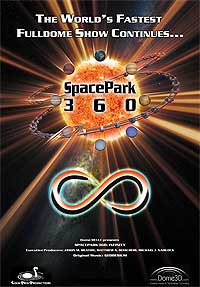 We think SpacePark360: Infinity is an amazingly creative and fun dome experience—one that takes you from Earth to exotic worlds in nothing flat!
We think SpacePark360: Infinity is an amazingly creative and fun dome experience—one that takes you from Earth to exotic worlds in nothing flat!
The SpacePark360 experience immerses audiences on fascinating rides located on distant worlds. SpacePark360: Infinity is a gorgeous successor to the original show, SpacePark360: Geodesium Edition, still in release. Both versions feature some out-of-this-world music by Geodesium.
We’re especially pleased to have SpacePark360 screened at two festivals (so far) this year: the 9th Fulldome Festival in Jena, Germany (Mark C. Petersen will be giving a talk about the soundtrack via Skype), and at the Fiske Fulldome Film Festival in Boulder, Colorado. Along with the show’s U.S. festival premieres, Mark plans to conduct a soundtrack workshop at Fiske.
To celebrate these Festival showings, we have a special two-part behind-the-scenes look at the production of this very exciting show project. This first part features the Dome3D visualization team, and part two focuses on the soundtrack production.
Visualizing SpacePark360: Infinity
We asked Matt Mascheri, Jason Heaton and Michael Narlock, the visual geniuses behind SpacePark360 about the show and the ideas behind it.
LNP: What inspired this second set of rides in the SpacePark360 series?
DOME3D: Virtually right after we released the original SpacePark360 we had customers asking us for more rides. So, during time between other projects, we worked on new Infinity rides. There were some that we wanted to create for the original release, but didn’t have time for so this was another reason for releasing a new show.
LNP: How did the immersive space of the dome influence the way you created the scenes?
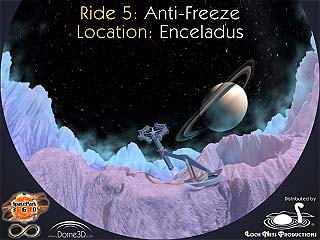 Dome3D: Every ride that we created was done with the dome in mind, meaning that we had to create vistas that wrapped around the viewer. The dome is the most immersive space where a group of people can have the same experience all together. We started to use the Oculus Rift DK1 for development, and it actually took the place of us using our small domes.
Dome3D: Every ride that we created was done with the dome in mind, meaning that we had to create vistas that wrapped around the viewer. The dome is the most immersive space where a group of people can have the same experience all together. We started to use the Oculus Rift DK1 for development, and it actually took the place of us using our small domes.
LNP: What are the inspirations for the rides in SpacePark360: Infinity?
Dome3D: After the original show, we realized that some domes augment existing astronomy programs with SpacePark360 rides. One planetarium uses the Mars ride to enhance a Mars program after the landing of the Curiosity rover. Some of the rides in the new show were inspired by this idea. We placed amusement park rides on some of the more interesting places of the solar system that, on occasion, are also hot topics in astronomy, such as Europa, with its ocean beneath the ice, or the Sun, which we had not visited before.
LNP: Any hidden meanings to any of the rides?
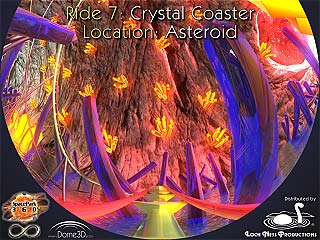 Dome3D: There are a few interesting stories behind the rides. After the success of the first show, we threw around the idea of setting our rides on exoplanets, the inside of asteroids, or even in the future. The “Crystal Coaster” is set inside an asteroid, with glowing crystals peppering the walls. Michael Narlock was responsible for nearly every piece of this ride. He said that his inspiration for this beautiful and colorful coaster was a picture of a cave in Mexico, covered in crystals. The idea was to give the idea of being inside a giant geode.
Dome3D: There are a few interesting stories behind the rides. After the success of the first show, we threw around the idea of setting our rides on exoplanets, the inside of asteroids, or even in the future. The “Crystal Coaster” is set inside an asteroid, with glowing crystals peppering the walls. Michael Narlock was responsible for nearly every piece of this ride. He said that his inspiration for this beautiful and colorful coaster was a picture of a cave in Mexico, covered in crystals. The idea was to give the idea of being inside a giant geode.
“Alien Fallout” is another ride inspired and created by Michael. To say that there are a lot of hidden meanings and messages in this ride would be an understatement. In the center of the ride itself, a giant rotating circle of seats, are two boxes that closely resemble something a number of domes may be familiar with: a Digistar 2 projector housing. All three of us each worked with these projectors. The fact that they begin to smoke mid-ride just adds to the fun.
Astute riders may also notice that in the center of the destroyed futuristic city are Interstate signs. Michael pointed out that this stemmed from the humor he finds in the fact that Hawai’i has an interstate.
LNP: What software did you use to generate the actual rides?
Dome3D: We used a combination of many different programs to create the rides. Primarily, we used 3D Studio Max for modeling and animation, and rendered with V-Ray.
LNP: How long does it take to create and finish a ride?
Dome3D: From inception until the finished product, each ride took, on average about four months to model, animate, and edit. Rendering, depending on the complexity of the ride, sometimes took just as long for a few of the larger rides.
LNP: How do you work together to create each ride?
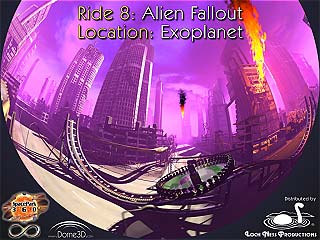 Dome3D: The process varies from ride to ride. Some, such as “Alien Fallout” and “Ice Slide”, are labors of love, having been worked on largely by one person with a few edits from the others. However, most of the rides were passed from person to person, often several times. We each added pieces that we had more experience with. Michael has more experience adding elements such as smoke and water. Jason has experience molding terrains around the rides, as well as animating complex rides such as the “Skrambler” or “Antifreeze.” Matt, who’s an excellent animator, is also very detail-oriented and great at optimizing rides and terrains so that they don’t take years to render.
Dome3D: The process varies from ride to ride. Some, such as “Alien Fallout” and “Ice Slide”, are labors of love, having been worked on largely by one person with a few edits from the others. However, most of the rides were passed from person to person, often several times. We each added pieces that we had more experience with. Michael has more experience adding elements such as smoke and water. Jason has experience molding terrains around the rides, as well as animating complex rides such as the “Skrambler” or “Antifreeze.” Matt, who’s an excellent animator, is also very detail-oriented and great at optimizing rides and terrains so that they don’t take years to render.
LNP: How do your individual tastes differ in terms of designing and rigging each ride?
Dome3D: Our tastes vary quite a bit, but only added to the final product. Michael enjoys lots of detail, hidden messages and Easter eggs. Jason enjoys adding twists throughout, such as falling off the rides. He also enjoys spends a lot of time working on the aesthetic feel of each ride and making sure it has engaging motion for the audience.
Matt spent time adding complexity to rides such as extra models and texturing landscapes. He was also great at balancing the fine line we created for ourselves merging environments that demanded correct astronomical reality, while taking artistic license to make sure the rides were fun.
LNP: How much dome testing did you do before finishing each ride?
Dome3D: Sometimes rides were promoted at conferences before the final product was completed, so that we could gauge audience reactions and input. Other rides were tested in fixed and portable domes, and even in virtual reality equipment such as the Oculus Rift.
LNP: What would you tell a planetarium to make them want to license this show?
Dome3D: It is flat out fun! We get that feedback from customers all the time. Since we developed the show in a modular fashion, theaters can run a single ride after regular programming, or the full show at any time. We’ve even had customers tell us that their audiences expect to see a SpacePark360 ride after the feature show. It is a great hook to get people into your theater who might normally not be there.
LNP: Many planetariums are in schools and their programs must fit into specific curriculum requirements. What would you tell a teacher about what this show teaches?
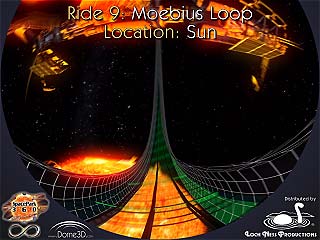 Dome3D: At the beginning of each ride there is a little intro that talks about the ride and environment that the audience is about to visit. There are also some clever little things we’ve done with the ride names. For example, we have Moebius Loop, which is styled after the Moebius strip in mathematics. In the original SpacePark360 show, we had “Quicksilver”, which is another name for Mercury. So, that’s the name we gave the ride we did on Mercury. Also, in the original show, we have “CH4“. That’s the chemical formula for methane, and the coaster that is hovering above a lake of methane on Titan. So while we don’t say that SpacePark360 is an educational show, there are some educational morsels buried in it.
Dome3D: At the beginning of each ride there is a little intro that talks about the ride and environment that the audience is about to visit. There are also some clever little things we’ve done with the ride names. For example, we have Moebius Loop, which is styled after the Moebius strip in mathematics. In the original SpacePark360 show, we had “Quicksilver”, which is another name for Mercury. So, that’s the name we gave the ride we did on Mercury. Also, in the original show, we have “CH4“. That’s the chemical formula for methane, and the coaster that is hovering above a lake of methane on Titan. So while we don’t say that SpacePark360 is an educational show, there are some educational morsels buried in it.
LNP: How has the show (or segments of it) been received at other facilities?
Dome3D: Places that license individual rides often come back for more. That’s the great thing about how we have structured SpacePark360. Once a facility licenses five rides, they get all nine of that show to complete the set.
LNP: Who do you think is the main audience for this show?
Dome3D: At first we thought that SpacePark360 would be geared toward the middle school/high school crowd. However, we found that younger children, especially those who have never been on a roller coaster, really love it. On the premiere night, we had a young kid, maybe 5, come back into the theater and ask to ride a coaster again because he loved it so much, and we were happy to do that for him. Anything that gets kids into the dome and interested about something — space, animation, the physics of roller coasters — it’s all good.
LNP: What is your favorite ride?
Dome3D: Michael’s favorite in the new show is “Moebius Loop”, a nod to one of the most successful ‘rides’ from the days of wireframe star projectors. His favorite in the original show is the Black Hole Coaster, because it was a great example of how successful a ride could be when the three of us used our talents to work together.
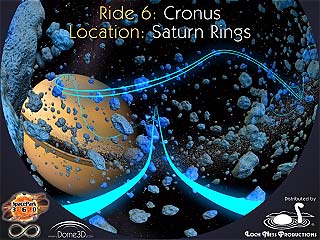 Jason’s favorite ride of the new show is “Ice Slide”, because it was created as a fluid process. It came together piece by piece in little ice segments added together, with the idea of having something new around every corner.
Jason’s favorite ride of the new show is “Ice Slide”, because it was created as a fluid process. It came together piece by piece in little ice segments added together, with the idea of having something new around every corner.
Matt’s favorite ride is “Cronus”, the roller coaster in the rings of Saturn. He thinks this ride has some of the most extreme motion. He also feels it is one of the most immersive environments we have created.
The real answer to the question, of course, is: what really matters to US is what the audiences think. What we have discovered is that almost every theater where the shows are played has a different favorite ride.
Part 1: Visualizing Space Park 360: Infinity
Part 2: Auralizing SpacePark360: Infinity

